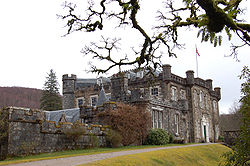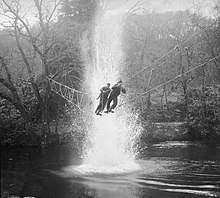
The Commandos, also known as the British Commandos, were formed during the Second World War in June 1940, following a request from Winston Churchill, for special forces that could carry out raids against German-occupied Europe. Initially drawn from within the British Army from soldiers who volunteered for the Special Service Brigade, the Commandos' ranks would eventually be filled by members of all branches of the British Armed Forces and a number of foreign volunteers from German-occupied countries. By the end of the war 25,000 men had passed through the Commando course at Achnacarry. This total includes not only the British volunteers, but volunteers from Greece, France, Belgium, Netherlands, Canada, Norway and Poland. The United States Army Rangers and US Marine Corps Raiders, Portuguese Fuzileiros Portuguese Marine Corps were modelled on the Commandos.

No. 62 Commando or the Small Scale Raiding Force (SSRF) was a British Commando unit of the British Army during the Second World War. The unit was formed around a small group of commandos under the command of the Special Operations Executive (SOE). They carried out a number of raids before being disbanded in 1943.
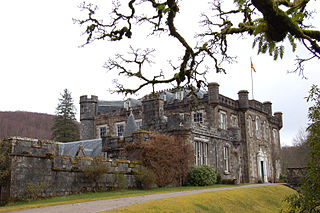
Achnacarry is a hamlet, private estate, and a castle in the Lochaber region of the Highlands, Scotland. It occupies a strategic position on an isthmus between Loch Lochy to the east, and Loch Arkaig to the west.

Lochailort is a hamlet in Scotland that lies at the head of Loch Ailort, a sea loch, on the junction of the Road to the Isles (A830) between Fort William and Mallaig with the A861 towards Salen and Strontian. It is served by Lochailort railway station on the West Highland Line.
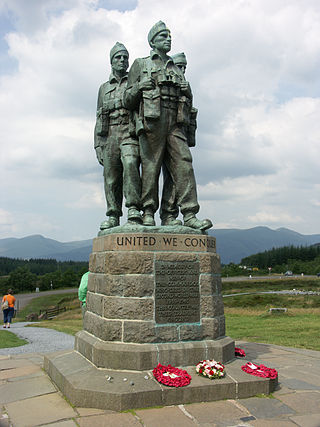
Spean Bridge is a village in the parish of Kilmonivaig, in Lochaber in the Highland region of Scotland.
No. 7 Commando was a unit of the British Commandos and part of the British Army during the Second World War. The commando was formed in August 1940 in the United Kingdom. No. 7 Commando was transferred to the Middle East as part of Layforce. Committed to the Battle of Crete, it suffered heavy casualties, after which it was disbanded.
No. 11 (Scottish) Commando was a battalion-sized commando unit of the British Army during the Second World War. Formed in Scotland, members of No. 11 (Scottish) Commando adopted the Tam o'shanter as their official headdress.

No. 12 Commando was a battalion-sized commando unit of the British Army during the Second World War. Formed in 1940 in Northern Ireland, they carried out a number of small-scale raids in Norway and France between 1941 and 1943 before being disbanded and its personnel dispersed to other commando units.
No. 5 Commando was a battalion-sized commando unit of the British Army during the Second World War.

No. 9 Commando was a battalion-sized British Commando unit raised by the British Army during the Second World War. It took part in raids across the English Channel and in the Mediterranean, ending the war in Italy as part of the 2nd Special Service Brigade. Like all Army commando units it was disbanded in 1946.
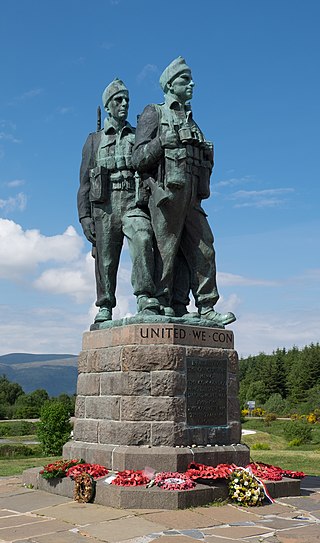
The Commando Memorial is a Category A listed monument in Lochaber, Scotland, dedicated to the men of the original British Commando Forces raised during World War II. Situated around a mile from Spean Bridge, it overlooks the training areas of the Commando Training Depot established in 1942 at Achnacarry Castle. Unveiled in 1952 by the Queen Mother, it is one of Scotland's best-known monuments, both as a war memorial and as a tourist attraction offering views of Ben Nevis and Aonach Mòr.

No. 10 (Inter-Allied) Commando was a commando unit of the British Army during the Second World War, recruited largely from non-British personnel from German-occupied Europe. This unit was used to help co-ordinate attacks with other Allied forces.
No. 2 Commando was a battalion-sized British Commando unit of the British Army during the Second World War. The first No.2 Commando was formed on 22 June 1940 for a parachuting role at Cambrai Barracks, Perham Down, near Tidworth, Hants. The unit at the time consisted of four troops: 'A', 'B', 'C' and 'D'. Eventually 11 troops were raised. On 21 November, it was re-designated as the 11th Special Air Service (SAS) Battalion and eventually re-designated 1st Parachute Battalion. After their re-designation as the 11th SAS Battalion, a second No. 2 Commando was formed. This No. 2 Commando was the leading commando unit in the St Nazaire Raid and suffered heavy casualties. Those who made it back from St Nazaire rejoined the few who had not gone on the raid, and the commando was reinforced by the first intake of volunteers from the new Commando Basic Training Centre at Achnacarry. No. 2 Commando then went on to serve in the Mediterranean, Sicily, Yugoslavia, and Albania, before being disbanded in 1946.
No. 50 Commando was a battalion-sized British Commando unit of the British Army during the Second World War. The commando was formed in 1940, from volunteers in Egypt and Palestine. Shortly after formation it was amalgamated with No. 52 Commando and became 'D' Battalion, Layforce.
No. 52 Commando was a battalion-sized British Commando unit of the British Army during the Second World War. The commando was formed in 1940, from volunteers in Egypt and Palestine. Shortly after formation it was amalgamated with No. 50 Commando and became 'D' Battalion, Layforce.
No. 51 Commando was a battalion-sized British Commando unit of the British Army during the Second World War. The commando was formed in 1940, from a combination of Jewish and Arab volunteers in Palestine. The Commando fought against the Italians in Abyssinia and Eritrea before it was absorbed into the Middle East Commando.
No. 14 (Arctic) Commando sometimes also called the Special Commando Boating Group, was a 60-man Commando unit of the British Army during the Second World War. The commando was formed in 1942 for service in the Arctic and was disbanded in 1943.
No. 46 Commando was a battalion size formation of the Royal Marines, part of the British Commandos, formed in August 1943 during the Second World War. The Commando was assigned to the 4th Special Service Brigade and served in North-west Europe and took part in the D-Day landings, as well as operations around Ostend and Antwerp, before being disbanded after the war in January 1946.
An independent company was originally a unit raised by the English Army, subsequently the British Army, during the 17th and the 18th centuries for garrison duties in Britain and the overseas colonies. The units were not part of larger battalions or regiments although they may have originally been detached from them, and the Units would remain permanently assigned to the garrison.
